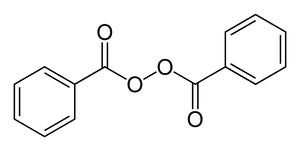 Image via Wikipedia
Image via WikipediaOne of the most commonly used ingredients, Benzoyl Peroxide can be very effective in treating mild cases of non-inflammatory acne. It’s safe for children as well as adults, and may combined with other topical or oral treatments.
Benzoyl Peroxide - HOW IT WORKS?
Benzoyl peroxide works by destroying P. acnes (Propionibacterium acnes), the bacteria that causes the condition acne. It acts as an antiseptic and oxidizing agent, reducing the number of comedones, or blocked pores. It may be 2–3 weeks before you begin to see improvement.
NOTE: While benzoyl peroxide kills existing P. acnes, it does not increase your body’s natural resistance to bacteria. So even when your breakouts begin to disappear, you should keep treating acne-prone areas. Why? This course of acne treatment kills bacteria, but it does not affect sebum production or the rate at which you shed your dead skin cells. If you stop using it, the bacteria — and your acne — will return.
Benzoyl Peroxide - WHERE TO GET IT?
Benzoyl peroxide is available in a wide range of gels, creams, lotions and cleansers in non-prescription concentrations of 2.5%, 5% and 10%. It is also available in presciption medications such as BenzaClin®, Benzamycin®, and Duac™. As with any product, read the label carefully and follow the instructions for proper use.
Benzoyl Peroxide - COMMON SIDE EFFECTS?
Dryness: The most common side effect, dryness is usually mild. If the skin is visibly scaly, apply a light oil-free moisturizer.
NOTE: If you experience dryness, irritation or dermatitis and are using a 5% or 10% solution of benzoyl peroxide, you may want to give your skin some time to heal — then try a lower concentration.
Irritation: If you experience mild irritation, try decreasing the frequency of use. If irritation is severe or persists even with infrequent application, discontinue use.
Dermatitis: Contact dermatitis (red, dry, itchy skin) can be due to irritation or allergy. Discontinue use immediately and treat with a mild topical steroid, such as hydrocortisone cream (available in most drugstores).
Allergy: 1–2% of the population experiences a mild allergic reaction to benzoyl peroxide. This is usually characterized by itching and redness.
Bleaching of clothing: Benzoyl peroxide can bleach clothing and linens; make sure your skin is completely dry before touching any cloth.














0 comments:
Post a Comment